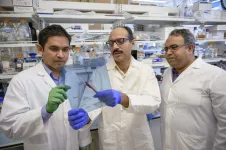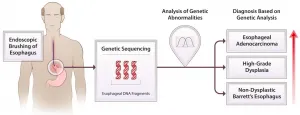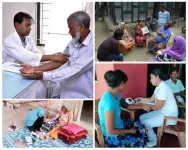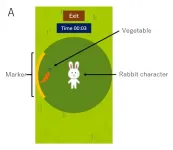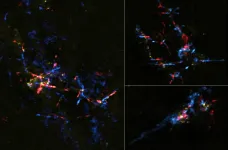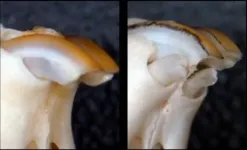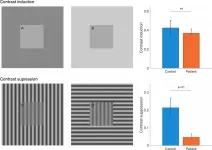SwRI scientists discover a new auroral feature on Jupiter
UVS images faint auroral rings that likely originate at edge of gas giant's magnetosphere
2021-03-29
(Press-News.org) SAN ANTONIO -- March 29, 2021 -- The SwRI-led Ultraviolet Spectrograph (UVS) orbiting Jupiter aboard NASA's Juno spacecraft has detected new faint aurora features, characterized by ring-like emissions, which expand rapidly over time. SwRI scientists determined that charged particles coming from the edge of Jupiter's massive magnetosphere triggered these auroral emissions.
"We think these newly discovered faint ultraviolet features originate millions of miles away from Jupiter, near the Jovian magnetosphere's boundary with the solar wind," said Dr. Vincent Hue, lead author of a paper accepted by the Journal of Geophysical Research: Space Physics. "The solar wind is a supersonic stream of charged particles emitted by the Sun. When they reach Jupiter, they interact with its magnetosphere in a way that is still not well understood."
Both Jupiter and Earth have magnetic fields that provide protection from the solar wind. The stronger the magnetic field, the larger the magnetosphere. Jupiter's magnetic field is 20,000 times stronger than Earth's and creates a magnetosphere so large it begins to deflect the solar wind 2-4 million miles before it reaches Jupiter.
"Despite decades of observations from Earth combined with numerous in-situ spacecraft measurements, scientists still do not fully understand the role the solar wind plays in moderating Jupiter's auroral emissions," said SwRI's Dr. Thomas Greathouse, a co-author on this study. "Jupiter's magnetospheric dynamics, the motion of charged particles within its magnetosphere, is largely controlled by Jupiter's 10-hour rotation, the fastest in the solar system. The solar wind's role is still debated."
One of the goals of the Juno mission, recently approved by NASA for an extension until 2025, is to explore Jupiter's magnetosphere by measuring its auroras with the UVS instrument. Previous observations with the Hubble Space Telescope and Juno have allowed scientists to determine that most of Jupiter's powerful auroras are generated by internal processes, that is the motion of charged particles within the magnetosphere. However, on numerous occasions, UVS has detected a faint type of aurora, characterized by rings of emissions expanding rapidly with time.
"The high-latitude location of the rings indicates that the particles causing the emissions are coming from the distant Jovian magnetosphere, near its boundary with the solar wind," said Bertrand Bonfond, a co-author on this study from Belgium's Liège University. In this region, plasma from the solar wind often interacts with the Jovian plasma in a way that is thought to form "Kelvin-Helmholtz" instabilities. These phenomena occur when there are shear velocities, such as at the interface between two fluids moving at different speeds. Another potential candidate to produce the rings are dayside magnetic reconnection events, where oppositely directed Jovian and interplanetary magnetic fields converge, rearrange and reconnect.
Both of these processes are thought to generate particle beams that could travel along the Jovian magnetic field lines, to eventually precipitate and trigger the ring auroras on Jupiter.
"Although this study does not conclude what processes produce these features, the Juno extended mission will allow us to capture and study more of these faint transient events," Hue said.
INFORMATION:
The Jet Propulsion Laboratory, a division of Caltech in Pasadena, California, manages the Juno mission for the principal investigator, Dr. Scott J. Bolton, of SwRI. Juno is part of NASA's New Frontiers Program, which is managed at NASA's Marshall Space Flight Center in Huntsville, Alabama, for the agency's Science Mission Directorate in Washington. Lockheed Martin Space in Denver built and operates the spacecraft.
For more information, read the paper at https://doi.org/10.1029/2020JA028971, visit https://www.swri.org/planetary-science.
[Attachments] See images for this press release:
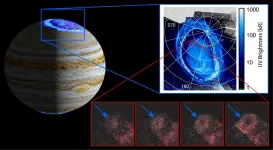
ELSE PRESS RELEASES FROM THIS DATE:
2021-03-29
SPOKANE, Wash. - New research led by scientists at Washington State University has found that a protein known as GBP5 appears to play a key role in suppressing inflammation in rheumatoid arthritis, a potentially debilitating disease in which the immune system mistakenly attacks the body's own joint tissues.
Published in the journal Arthritis & Rheumatology, the discovery could someday lead to new treatments to slow or halt the progress of the disease, which affects an estimated 1.5 million Americans. The researchers said it may also have applications in other inflammatory diseases.
First author ...
2021-03-29
A combination of esophageal brushing and extensive genetic sequencing of the sample collected can detect chromosome alterations in people with Barrett's Esophagus, identifying patients at risk for progressing to esophageal cancer, according to a new study by researchers at the Johns Hopkins Kimmel Cancer Center and Case Western Reserve University.
In Barrett's Esophagus (BE), chronic acid reflux from the stomach damages the cells lining the lower esophagus, causing them to become more like cells of the lower digestive system. Cells in the lower esophagus progress through several precancerous stages before sometimes developing into esophageal adenocarcinoma, a cancer with a five-year survival rate below 20 percent. BE is the only known precursor to esophageal adenocarcinoma.
Clinicians ...
2021-03-29
EU imports of products including palm oil, soybeans, and beef contribute significantly to deforestation in other parts of the world. In a new study, researchers from Chalmers University of Technology, Sweden, and the University of Louvain, Belgium, evaluated over a thousand policy proposals for how the EU could reduce this impact, to assess which would have the largest potential to reduce deforestation - while also being politically feasible.
"Unsurprisingly, there is weaker support for tougher regulations, such as import restrictions on certain goods. But our study shows that there is broad support in general, ...
2021-03-29
New genetic analysis and years of painstaking research has revealed that one of the world's most endangered marine mammals is actually two species rather than one, as scientists had long assumed.
Scientists spent about two decades crossing Asia and Europe in pursuit of river dolphins skulls and reexamining tissue samples with modern genetic techniques. Their findings revealed that Indus and Ganges river dolphins are separate species, according to a new study published in Marine Mammal Science.
The two dolphins that live in the muddy waters ...
2021-03-29
SINGAPORE, 29 March 2021 - A low-cost intervention to improve hypertension--or high blood pressure (BP)--prevention and management can be cost-effectively scaled up for rural communities in low- and middle-income countries, according to findings from a multi-country trial published in The Lancet Global Health.
Led by Duke-NUS Medical School in Singapore, the Control of Blood Pressure and Risk Attenuation--Bangladesh, Pakistan, Sri Lanka (COBRA-BPS) trial, conducted in partnership with the International Centre for Diarrhoeal Diseases Research, Bangladesh (ICDDR,B), Aga Khan University in Pakistan, the University of Kelaniya in Sri Lanka, analysed the budget impact and cost-effectiveness ...
2021-03-29
A Japanese research group combined motion analysis that uses smartphone application and machine learning that uses an anomaly detection method, thereby developing a technique to easily screen for carpal tunnel syndrome. Carpal tunnel syndrome is common amongst middle-aged women. The disease causes compressed nerves in the wrist, causing numbness and difficulty with finger movements. While an accurate diagnosis can be reached with nerve conduction study, this is not widely used because it requires expensive devices and specialized skills. Thus, a simple screen tool that does ...
2021-03-29
Astronomers found a number of stellar eggs containing baby stars around the center of the Milky Way using the Atacama Large Millimeter/submillimeter Array (ALMA). Previous studies had suggested that the environment there is too harsh to form stars. These findings indicate that star formation is more resilient than researchers thought.
Stars form in stellar eggs, cosmic clouds of gas and dust which collapse due to gravity. If something interferes with the gravity driven contraction, star formation will be suppressed. There are many potential sources of interference near the Galactic Center. Strong turbulence can stir up the clouds ...
2021-03-29
Japan -- The tooth fairy is a welcome guest for any child who has lost a tooth. Not only will the fairy leave a small gift under the pillow, but the child can be assured of a new tooth in a few months. The same cannot be said of adults who have lost their teeth.
A new study by scientists at Kyoto University and the University of Fukui, however, may offer some hope. The team reports that an antibody for one gene -- uterine sensitization associated gene-1 or USAG-1 -- can stimulate tooth growth in mice suffering from tooth agenesis, a congenital condition. The paper was published in Science Advances.
Although the normal adult mouth has 32 teeth, about ...
2021-03-29
A group of researchers from Russia, Germany, the Czech Republic, and Switzerland contest the common belief that resource-based economies have higher levels of within-country inequality than resource-scarce economies. The researchers document a direct causal link between natural resources and within-country inequality and conclude that the extraction of oil and gas can reduce inequality or has no significant effect on it. The results were published in the journal Empirical Economics.
"When we compare the natural resource rents to GDP 10 years after the discovery of natural ...
2021-03-29
Researchers specialised in psychiatry and psychology at the University of Helsinki investigated the effects of depression on visual perception. The study confirmed that the processing of visual information is altered in depressed people, a phenomenon most likely linked with the processing of information in the cerebral cortex.
The study was published in the Journal of Psychiatry and Neuroscience.
In the study, the processing of visual information by patients with depression was compared to that of a control group by utilising two visual tests. In the perception tests, the study subjects compared the brightness and contrast of simple patterns.
"What ...
LAST 30 PRESS RELEASES:
[Press-News.org] SwRI scientists discover a new auroral feature on Jupiter
UVS images faint auroral rings that likely originate at edge of gas giant's magnetosphere

